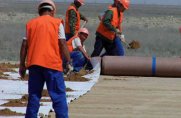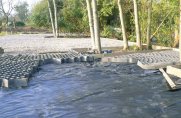- Market Sector
- Application Function
- Products
- Geotextiles
- Geocomposites
- Geocomposite Drains

Geocomposite Drains
Terram geocomposite drains are designed to replace 'traditional' solutions and are highly effective in the collection and conveyance of both liquids and gases. - Salt Barrier Geocomposite

Salt Barrier geocomposite
Developed to prevent damage caused by the capillary rise of saline groundwater into 'sweet' soil zones. - Frost Blanket Geocomposite

Frost Blanket
A purpose-designed, protection geo-composite for mitigating the effects of frost heave. - PW2 (Railway Track-bed Drains)

PW2 trackbed robust separator
A robust separator / filter incorporating a stiff net between two textile filter layers.
- Geocomposite Drains
- Geocells
- Erosion Control

Erosion Control Geocell
Terram geocell is a relatively shallow cellular confinement system which is used to combat erosion on slopes up to 1:1. - Retaining Wall

Soil Structure Geocell
Terram Series 500 Geocell provides a cost-effective alternative to conventional earth retention structures. - Tree Root Protection / Load Platform Geocell

Tree Root Protection Geocell
Terram geocell is a cellular confinement system that is used to protect tree roots from damage caused by heavy vehicles.
- Erosion Control
- Geonets
- Landscape Fabrics
- Consumer / DIY
- Downloads
- About Us
- Contact Us
Terram Geosynthetics are extensively used in civil engineering in the construction of highways - from preventing intermixing of sub-base and subgrade layers, control erosion on cut slopes, for roadside drainage, as part of SUDS projects for infrastructure access and in the construction of retaining walls, bridge abutments and steep slopes.
Geotextile selection
Products
The thickness of a sub-base and/or capping layer should be determined using appropriate national design criteria. Other more simplified procedures may be adopted if these do not exist or are inappropriate.
For example, the nomogram shown is for the design of unpaved roads and may be used to check initial layer thicknesses for a
paved road.
Where information is scarce, the following may prove useful for the selection and installation of the most appropriate TERRAM grade. These guidelines should not be used to replace more rigorous design and the experience of contractors familiar with the installation
of geotextiles.
The selection of the most appropriate TERRAM grade is largely dependent on the strength and moisture content of the subgrade. Site investigation should be used to assess these parameters. 5 may be used for guidance in the absence of field data.
Grade selectionThe TERRAM grade must be sufficiently robust to resist installation damage. The lower the subgrade strength and the larger the stone, the more robust the grade needs to be.
InstallationThe area should be cleared of any large objects, such as stones and tree stumps, before geotextile placement. Ruts and sharp undulations in excess of 100mm should be filled and levelled. Strong perennial weeds, such as thistles, should be treated with weed killer. Other vegetation can be left undisturbed, if this is allowable and not detrimental to the structure. The presence of surface vegetation can actually aid construction with very soft soils i.e. CBR
TERRAM geotextiles can be unrolled directly onto a subgrade with adjacent and subsequent rolls overlapped between 300mm and 1000mm - the softer the subgrade, the greater the overlap. A combination of overlapping and sewing may be more economical where the subgrade strength is particularly low, or in other critical situations (see the TERRAM Jointing bulletin).
Vehicles and plant must not run directly on exposed textile. Construction traffic should be restricted to areas of textile which have been covered with sub-base and preferably compacted to the minimum required depth.
Sub-base selection and placementThe sub-base must be well-graded, compactable and for permanent works, capable of transporting rising water and resistant to long-term degradation. Recommended grading bands for compactable granular materials are shown.
The sub-base thickness will depend on loading and on the strength of the subgrade. The thickness should take into account the maximum anticipated axle load, both during construction and in service, and should be increased by 10-20% on bends or where a slightly inferior sub-base is used.
Sub-base should be bladed forward over the textile and graded down to the required un-compacted depth. Typical practice with a firm subgrade is to place the sub-base in layers which are compacted to 150mm using a vibro-roller. Further advice is provided in the Department for Transport’s Specification for Highways Works.



With a soft subgrade it is prudent to place at least 300mm of lightly-compacted sub-base in one lift (500mm on an exceptionally soft subgrade) before overlaying this with a thinner layer of better-compacted material.
A very low-CBR subgrade, heavier traffic loadings, or a poorly-graded sub-base may require differing techniques. For example, heavy compaction with a very soft clay subgrade can lead to rutting and heave, and it may be necessary to increase the initial layer thickness and allow time for consolidation of the subgrade before the placement of thinner layers and applying more intense compaction.



















